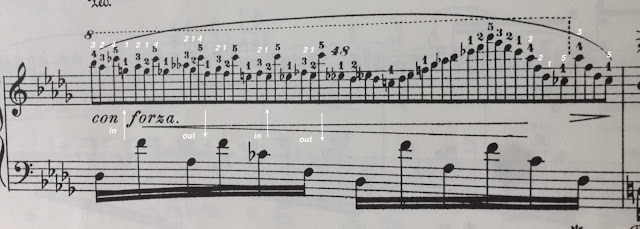When I was a mere lad, my teacher assigned Chopin's Nocturne in D-flat, Op. 27, No. 2. It was a favorite of mine and I was eager to study it. All went well until that pesky melisma near the end. You know the one I mean—the one that tends to jam in speed when the hand gets out of synch. Somehow, the passage worked for me most of the time, but I was never happy with it until years later when I understood better what was at stake. I was reminded of this recently when a student appeared with his hand out of whack from having struggled with it. It was my job to help him smooth it back into shape.
Notice that the music changes direction with every note. This is a job for forearm rotation, our fastest movement and one that our bodies are designed to do easily and forever—well, a very long time. The hand will lock and the notes will jam if each note doesn't get its full attention, if the weight isn't transferred back and forth. So, if this passage bothers you, practice slowly feeling balanced on each note before going on to the next. Notice also where the hand is in relation to the black keys; move in just before playing the thumb on a black key and back out again for successive white keys. I've added the fingering I use, all though the editor's fingering will work, fussy though it is. Click on the example to enlarge:
Another tool I use is called grouping. If the above fingering and in/out shaping isn't enough to make the passage feel easy, consider organizing groups of four notes beginning with the C-flat. If the first note of the group is C-flat, group from the second note, the first one a G. So, G, A-flat, G, C-flat and land back silently on the next starting note, G-flat. Always land on the first note of the next group.
Rotation
Grouping



1 comment:
A nice explanation of a thorny passage that has plagued me for decades! Thank you, Dr. Stannard. Btw, please get a piano :)
Post a Comment